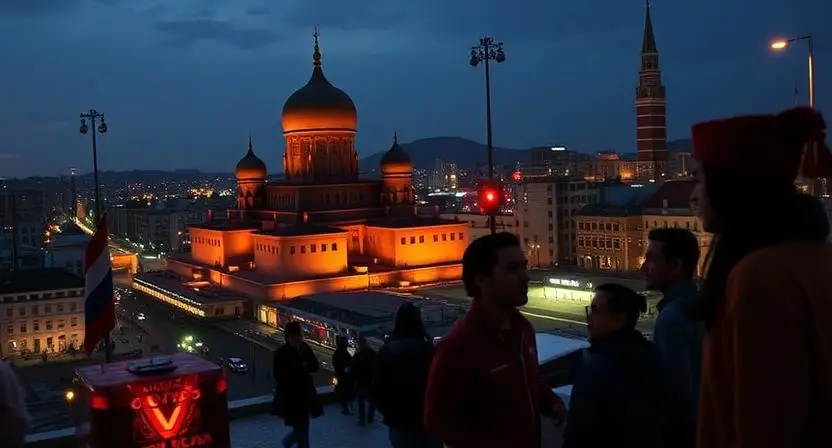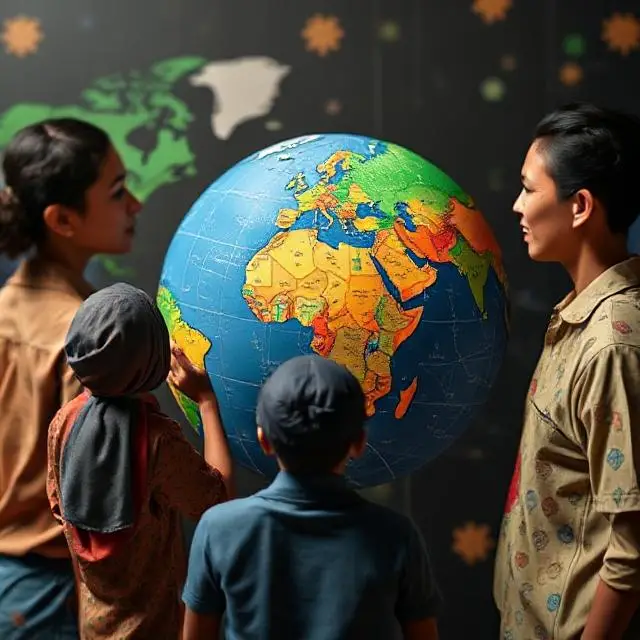Globalization is reshaping cultures around the world in profound ways. As technology, trade, and communication continue to connect people across borders, cultural identities are both challenged and redefined. On one hand, it brings about new opportunities for cross-cultural exchange, while on the other, it raises concerns about the erosion of traditional values and practices. The question remains: how is globalization changing cultural identities, and what does the future hold for the preservation of unique cultural heritages?
The Impact of Globalization on Traditional Cultures
Globalization’s reach has deeply impacted traditional cultures in both positive and negative ways. One of the most visible outcomes is the spread of Western ideals and lifestyles, which influence everything from clothing choices to societal values. While this cultural exchange can lead to increased understanding and shared experiences, it often results in the dilution or even loss of indigenous practices and beliefs.
The Erosion of Indigenous Languages and Practices
One of the most significant impacts of globalization is the erosion of indigenous languages and cultural practices. As more people adopt global languages like English, Spanish, and Mandarin for business and social interactions, local languages begin to fade into obscurity. In many cases, younger generations are less likely to speak their ancestral languages or engage in traditional activities, such as crafts, music, and dance, that have been passed down through the centuries. This loss threatens the rich cultural diversity of many regions and leaves these communities vulnerable to becoming cultural minorities within their own countries.
Westernization vs. Cultural Preservation Efforts
The spread of Western culture is often seen as a driving force behind the homogenization of global cultural identities. Western media, consumer products, and lifestyle choices, including fast food, fashion, and entertainment, have become ubiquitous across the globe. However, many nations are actively resisting the overwhelming dominance of Westernization. Cultural preservation efforts through laws protecting traditional languages, art forms, and religious practices are gaining traction in many countries. For example, France’s “cultural exception” law aims to protect its domestic film industry from the global influence of Hollywood. These efforts demonstrate the tension between embracing global trends and maintaining a connection to local heritage.
Case Studies: How Countries Are Adapting (e.g., Japan, India, Mexico)
Countries like Japan, India, and Mexico have found unique ways to adapt to globalization without sacrificing their cultural identities. Japan, for instance, has integrated global influences, such as Western fashion and pop culture, into its own distinct style, resulting in a unique blend of tradition and modernity. Similarly, India has embraced global business practices while ensuring that its cultural festivals, language diversity, and cuisine remain integral to the national identity. Mexico has faced challenges with its indigenous culture’s survival, but initiatives to protect indigenous languages and traditions, along with the rise of the global appeal of Mexican cuisine, demonstrate that cultural preservation is possible even in the face of rapid globalization.

The Rise of Hybrid and Global Cultures
Globalization has led to the emergence of hybrid cultures, where elements from various cultural traditions are fused to create something entirely new. These hybrid identities often reflect the interconnectedness of the world, where cultures no longer exist in isolation but rather interact, mix, and influence each other.
How Fusion Cuisine, Fashion, and Music Reflect Cultural Blending
One of the most prominent examples of hybrid cultures is fusion cuisine, where chefs combine ingredients and techniques from different culinary traditions to create innovative dishes. Sushi burritos, tacos with Korean fillings, and Indian-inspired burgers reflect how globalization has created a melting pot of culinary experiences. Similarly, fashion trends increasingly combine traditional garments with global styles, and music genres blend influences from across the world. Artists like Shakira, who mixes Latin rhythms with pop and rock, are a perfect example of how cultural blending is redefining music across the globe.
The Role of Social Media in Spreading Global Trends
Social media platforms like Instagram, TikTok, and YouTube have accelerated the spread of global cultural trends. With just a few clicks, people from diverse corners of the world can access fashion ideas, music videos, and travel destinations from countries they may have never visited. Influencers and digital creators play a huge role in spreading global cultural norms, making hybrid identities more accessible and widely accepted. The viral nature of these trends allows them to transcend geographical boundaries, creating a global culture that is continually evolving.
Diaspora Communities and Their Influence on Cultural Exchange
Diaspora communities are another key factor in the blending of cultures. As people move across borders, they bring their traditions, languages, and customs with them, contributing to the cultural diversity of their new homes. In turn, these communities also adapt to the new cultural environment, creating hybrid identities that combine elements from both their homeland and their adopted country. For example, in cities like New York, London, and Toronto, the presence of multiple diaspora communities has led to the rise of multicultural neighborhoods where diverse cuisines, languages, and traditions are celebrated and integrated into the daily life of the city.
The Role of Technology and Media in Shaping Identities
Technology and media play pivotal roles in shaping modern cultural identities. From global television networks to digital streaming platforms, the media serves as a powerful tool for the dissemination of cultural norms, values, and narratives.
Hollywood, K-Pop, and Bollywood: Dominance of Global Entertainment
Hollywood has long been the dominant force in global entertainment, with films and television series reaching audiences worldwide. However, the rise of K-Pop and Bollywood has highlighted the growing influence of non-Western entertainment industries. K-Pop, with its meticulously choreographed performances and addictive pop music, has garnered massive global followings, particularly among younger audiences. Bollywood’s influence is also spreading globally, showcasing Indian culture through films that address universal themes. These examples show that cultural production is no longer confined to the West but is becoming increasingly diversified.
How Streaming Platforms Are Redefining Local Narratives
Streaming platforms like Netflix, Amazon Prime, and Disney+ have revolutionized the way people consume media. These platforms feature content from various countries, making it easier for people to access stories and shows that reflect different cultural backgrounds. Shows like “Money Heist” (Spain), “Sacred Games” (India), and “Narcos” (Colombia) have gained international acclaim, proving that local narratives can resonate with global audiences. This accessibility has the potential to enhance cultural understanding, while also allowing traditional cultures to gain a broader audience.
The Double-Edged Sword: Cultural Appropriation vs. Appreciation
As global culture blends, the line between cultural appropriation and cultural appreciation can become blurred. Cultural appropriation occurs when elements of a marginalized culture are used by members of a dominant culture in a way that disrespects the original meaning or significance. The commercialization of traditional clothing, hairstyles, and symbols without an understanding of their cultural importance has sparked debates and protests worldwide. On the other hand, cultural appreciation involves learning about and respecting another culture’s traditions and values. The key difference lies in the intention and respect behind the use of cultural elements.
Resistance and Revival: Can Cultural Identities Survive Globalization?
While globalization has led to a growing hybrid culture, there are significant efforts to resist cultural homogenization and protect traditional identities. These efforts are rooted in the belief that cultural diversity is essential for a harmonious and balanced global society.
Grassroots Movements Fighting Cultural Homogenization
Grassroots movements around the world are pushing back against the erasure of local cultures. Activists are organizing to protect indigenous languages, traditional art forms, and local customs from being overshadowed by global influences. In the United States, for instance, Native American communities have been advocating for the revitalization of their languages and the preservation of sacred traditions. Similarly, in Africa, movements to promote the use of indigenous languages and support local crafts are gaining momentum.
Governments and Policies Protecting National Heritage
Governments are also taking action to protect national heritage through policies and initiatives. UNESCO’s Intangible Cultural Heritage program supports efforts to safeguard cultural practices that are at risk of disappearing. Countries such as China and Italy have enacted laws to protect their traditional arts and crafts, and many nations offer financial incentives for the preservation of cultural sites and artifacts.
The Future of Cultural Diversity in a Globalized World
The future of cultural diversity in a globalized world is uncertain. While globalization presents opportunities for cultural exchange and the growth of hybrid identities, it also poses challenges to the survival of traditional practices. The key to preserving cultural diversity will be finding a balance between embracing global trends and maintaining local traditions. The rise of awareness regarding cultural preservation, alongside global efforts to support cultural diversity, offers hope for the continued existence of distinct cultural identities.
Conclusion
Globalization is undoubtedly changing cultural identities, with both positive and negative consequences. While global culture has led to cultural blending and the rise of hybrid identities, it has also posed challenges to the preservation of traditional practices and beliefs. As nations continue to adapt, the future of cultural diversity depends on the ability to embrace globalization without losing the richness of local traditions. Will globalization lead to a unified world culture, or can traditional cultures thrive alongside modernity? Only time will tell, but the ongoing efforts to preserve cultural heritage indicate that it is possible to maintain a balance between the global and the local.
FAQs: How Globalization is Changing Cultural Identities
1. What is cultural globalization?
Cultural globalization refers to the rapid exchange of ideas, values, traditions, and lifestyles across the world due to increased connectivity (internet, trade, travel). This leads to both cultural blending and the potential erosion of local identities.
2. How does globalization threaten local cultures?
Globalization can weaken local cultures by:
Homogenization: Dominance of Western media, fast food, and fashion.
Language Loss: Indigenous languages decline as English becomes a global lingua franca.
Consumerism: Traditional crafts and practices are replaced by mass-produced goods.
3. Can globalization also enrich cultures?
Yes! Globalization fosters:
Cultural Hybridization: Fusion cuisines, music genres (e.g., K-pop blending hip-hop), and fashion.
Diaspora Influence: Migrant communities spread traditions globally (e.g., Diwali celebrations in the U.S.).
Access to Diversity: People learn about other cultures through travel, media, and education.
4. What are examples of cultures resisting globalization?
France: Laws protecting the French language from excessive Anglicization.
Bhutan: Prioritizing "Gross National Happiness" over Western consumerism.
Indigenous Movements: Activism to preserve native languages and land rights (e.g., Māori in New Zealand).
5. Is cultural identity disappearing because of globalization?
Not necessarily it’s evolving. While some traditions fade, others adapt or merge with global influences. The key challenge is balancing modernization with heritage preservation.

